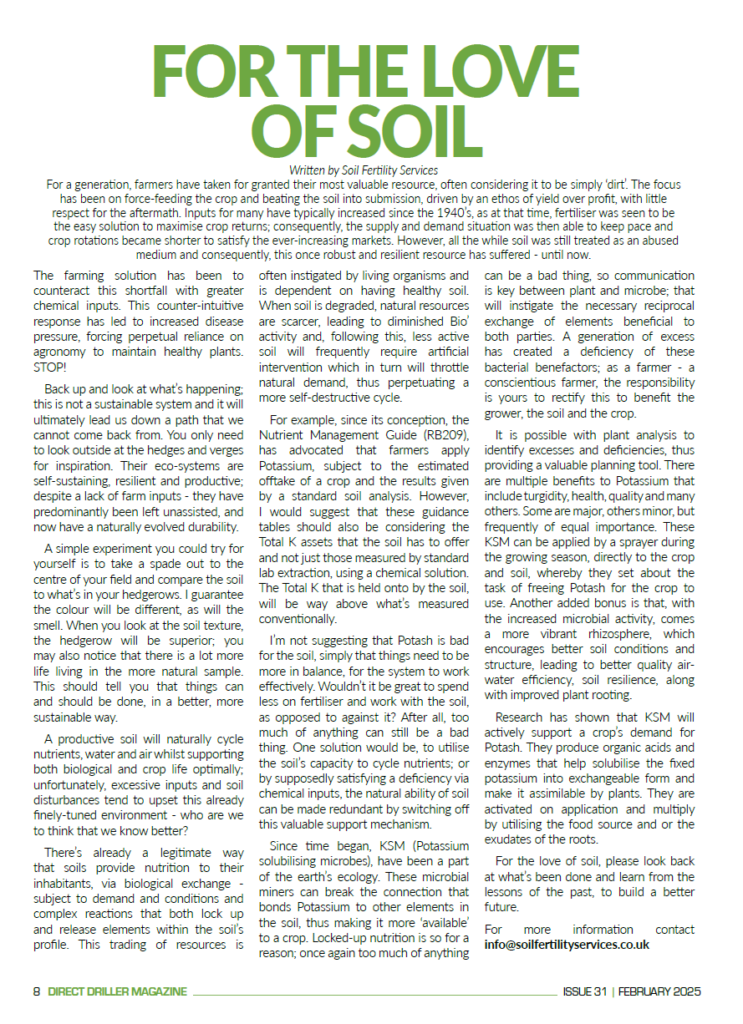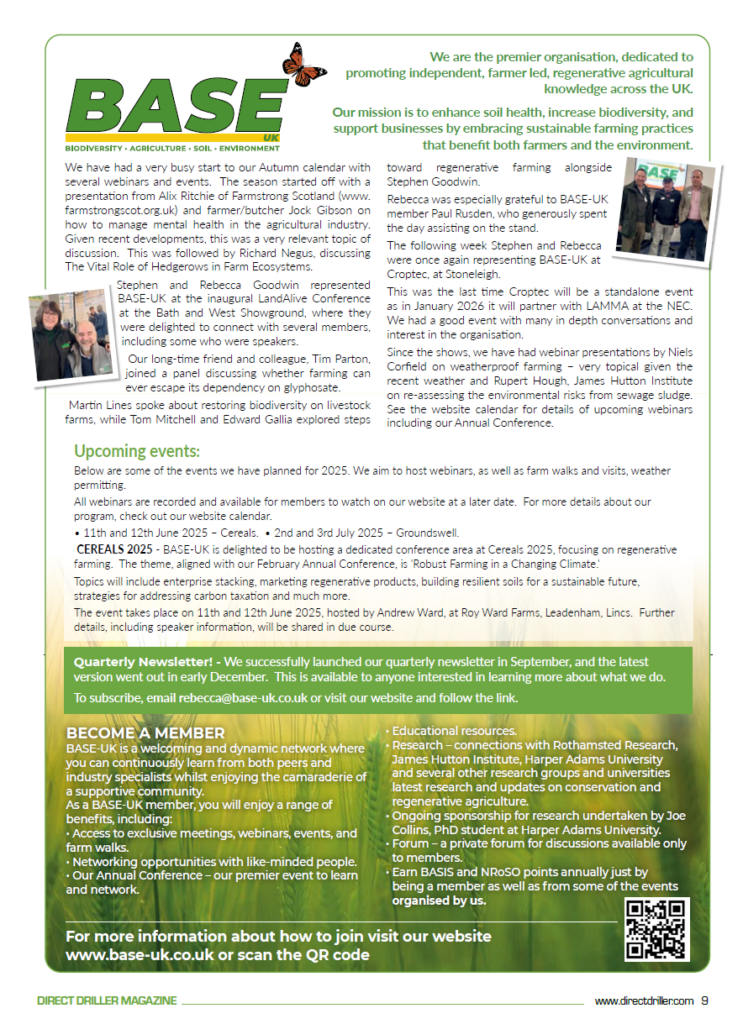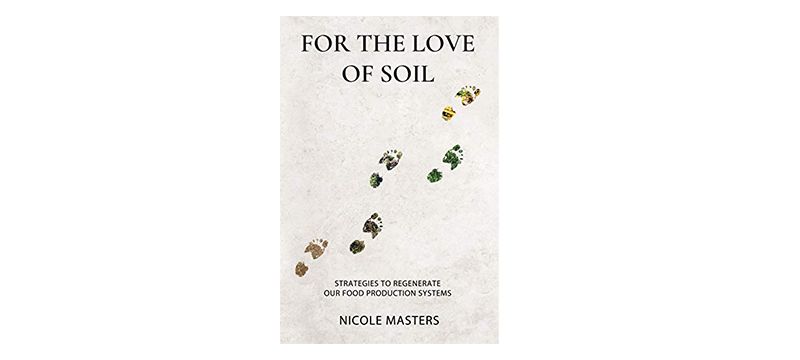For a generation, farmers have taken for granted their most valuable resource, often considering it to be simply ‘dirt’. The focus has been on force-feeding the crop and beating the soil into submission, driven by an ethos of yield over profit, with little respect for the aftermath. Inputs for many have typically increased since the 1940’s, as at that time, fertiliser was seen to be the easy solution to maximise crop returns; consequently, the supply and demand situation was then able to keep pace and crop rotations became shorter to satisfy the ever-increasing markets. However, all the while soil was still treated as an abused medium and consequently, this once robust and resilient resource has suffered – until now.
The farming solution has been to counteract this shortfall with greater chemical inputs. This counter-intuitive response has led to increased disease pressure, forcing perpetual reliance on agronomy to maintain healthy plants. STOP!
Back up and look at what’s happening; this is not a sustainable system and it will ultimately lead us down a path that we cannot come back from. You only need to look outside at the hedges and verges for inspiration. Their eco-systems are self-sustaining, resilient and productive; despite a lack of farm inputs – they have predominantly been left unassisted, and now have a naturally evolved durability.
A simple experiment you could try for yourself is to take a spade out to the centre of your field and compare the soil to what’s in your hedgerows. I guarantee the colour will be different, as will the smell. When you look at the soil texture, the hedgerow will be superior; you may also notice that there is a lot more life living in the more natural sample. This should tell you that things can and should be done, in a better, more sustainable way.
A productive soil will naturally cycle nutrients, water and air whilst supporting both biological and crop life optimally; unfortunately, excessive inputs and soil disturbances tend to upset this already finely-tuned environment – who are we to think that we know better?
There’s already a legitimate way that soils provide nutrition to their inhabitants, via biological exchange – subject to demand and conditions and complex reactions that both lock up and release elements within the soil’s profile. This trading of resources is often instigated by living organisms and is dependent on having healthy soil. When soil is degraded, natural resources are scarcer, leading to diminished Bio’ activity and, following this, less active soil will frequently require artificial intervention which in turn will throttle natural demand, thus perpetuating a more self-destructive cycle.
For example, since its conception, the Nutrient Management Guide (RB209), has advocated that farmers apply Potassium, subject to the estimated offtake of a crop and the results given by a standard soil analysis. However, I would suggest that these guidance tables should also be considering the Total K assets that the soil has to offer and not just those measured by standard lab extraction, using a chemical solution. The Total K that is held onto by the soil, will be way above what’s measured conventionally.
I’m not suggesting that Potash is bad for the soil, simply that things need to be more in balance, for the system to work effectively. Wouldn’t it be great to spend less on fertiliser and work with the soil, as opposed to against it? After all, too much of anything can still be a bad thing. One solution would be, to utilise the soil’s capacity to cycle nutrients; or by supposedly satisfying a deficiency via chemical inputs, the natural ability of soil can be made redundant by switching off this valuable support mechanism.
Since time began, KSM (Potassium solubilising microbes), have been a part of the earth’s ecology. These microbial miners can break the connection that bonds Potassium to other elements in the soil, thus making it more ‘available’ to a crop. Locked-up nutrition is so for a reason; once again too much of anything can be a bad thing, so communication is key between plant and microbe; that will instigate the necessary reciprocal exchange of elements beneficial to both parties. A generation of excess has created a deficiency of these bacterial benefactors; as a farmer – a conscientious farmer, the responsibility is yours to rectify this to benefit the grower, the soil and the crop.
It is possible with plant analysis to identify excesses and deficiencies, thus providing a valuable planning tool. There are multiple benefits to Potassium that include turgidity, health, quality and many others. Some are major, others minor, but frequently of equal importance. These KSM can be applied by a sprayer during the growing season, directly to the crop and soil, whereby they set about the task of freeing Potash for the crop to use. Another added bonus is that, with the increased microbial activity, comes a more vibrant rhizosphere, which encourages better soil conditions and structure, leading to better quality air-water efficiency, soil resilience, along with improved plant rooting.
Research has shown that KSM will actively support a crop’s demand for Potash. They produce organic acids and enzymes that help solubilise the fixed potassium into exchangeable form and make it assimilable by plants. They are activated on application and multiply by utilising the food source and or the exudates of the roots.
For the love of soil, please look back at what’s been done and learn from the lessons of the past, to build a better future.
For more information contact info@soilfertilityservices.co.uk


